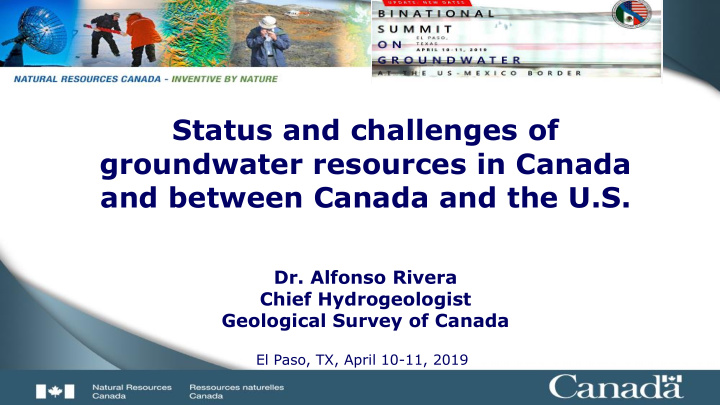



1 Status and challenges of groundwater resources in Canada and between Canada and the U.S. Dr. Alfonso Rivera Chief Hydrogeologist Geological Survey of Canada El Paso, TX, April 10-11, 2019
2 North American Context Canada U.S.A. MEXICO Area ~10 M km 2 Area ~9.8 M km 2 Area ~2 M km 2 World 2 nd largest World 3 rd /4 th largest World 14 th largest 37 M inhabitants 330 M inhabitants 127 M inhabitants GW use 30% GW use 50% GW use 60% GW resources - Prov. Gov. GW resources - States Gov. GW resources - Fed Gov. GW recharge – 385 km 3 /yr GW recharge – 1300 Km 3 /yr GW recharge – 307 km 3 /yr GW use – 1 km 3 /yr GW use – 115 Km 3 /yr GW use – 50 Km 3 /yr GW in storage- 90 000 km 3 GW in storage- 200 000 km 3 GW in storage- 458 km 3
3 Canada’s Groundwater Resources (Rivera, 2014)
4 Canada’s groundwater resources and groundwater use Canadian Geographic , (adapted from Rivera, 2014)
5 Canada’s Groundwater Resources STATUS Data Information Availability Management Sustainability: Surface-water resources: more or less complete • Groundwater resources: still incomplete •
6 A big challenge: The management of water resource of Canada • Decentralized Government. • 20 federal departments are involved in water issues. • Water resources management is shared by 13 jurisdictions. • There is no Canadian water policy. • GW regulations differ from province to province. • A common vision for GW resources assessment and management for Canada is slowly emerging.
7 Canada’s Groundwater Resources ISSUES • Renewable water – vs – Fossil water • Availability – vs – Sustainability (use) • Space and time scales • Recharge – vs – Discharge • Climate variability – vs – Climate Change • Transboundary groundwater – vs- Transboundary aquifers Trying to clear and agree upon these before harmonizing transboundary approaches
8 Canada-United States Shared Boundary Waters (IJC, 2017) • Near 300 water ways along more than 8800 km • Over 20 million Canadians live in watersheds that cross the Canada-USA border
9 Groundwater Resources between Canada and the U.S. (Rivera, 2015)
10 The Milk River Transboundary Aquifer case: The Milk River TBA – UNESCO #20N, 30’000 km 2 (Pétré et al., 2016)
11 Aquifer Boundaries or Groundwater Flow Systems? Scale matters 1M – 1.5 M years 750K years 500K years 250K years Recent (Pétré et al., 2016)
12 Aquifer Boundaries or Groundwater Flow Systems? Multiple stakes, multiple interests Industry interests: Municipalities interests: Gas field, wells issues Technical & Social issues Provincial government interests: GW allocation and management State government First Nations interests: interests: Environment & Social GW allocation and issues management (Rivera, 2017) US/Canada interests: Assessment, planning, sharing, conflict resolution
13 Canada – US transboundary aquifers Special Case: The Great Lakes Basin Many unconsolidated Quaternary aquifers contribute to the GLB’s water • balance; however, they are still to be identified as transboundary. Plans to build a 3D SW/GW model of the GLB by the two countries, • which will likely identify the transboundariness of the aquifers.
14 Groundwater Resources between Canada and the U.S. The International Joint Commission (IJC, Canada/US) has issued its triennial assessment report that recommends activities to improve the understanding of groundwater and its connectivity to surface waters in the shared waters of the Great Lakes Basin (IJC, 2017 ). (Rivera, 2015)
Recommend
More recommend